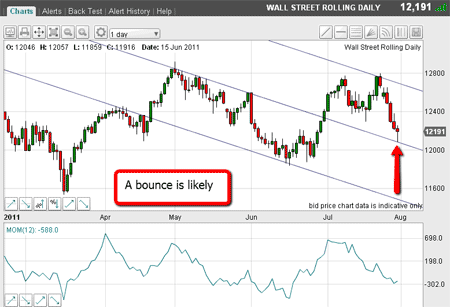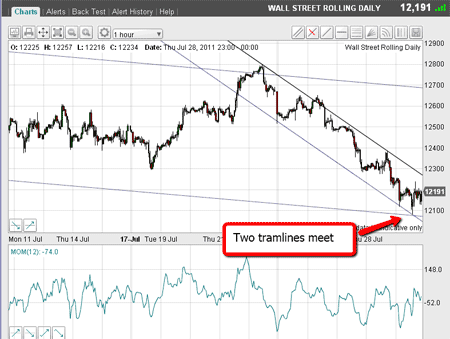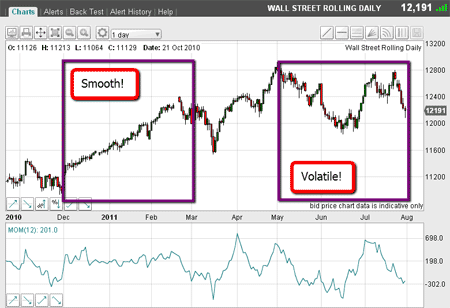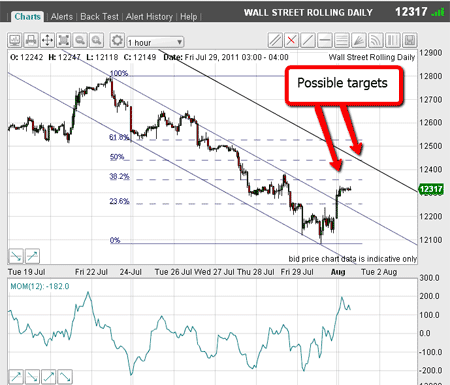The most important skill for a trader to learn – risk management
Even the best traders make huge numbers of losing trades – the trick is to keep your losses small and your profits large. That's why learning to manage risk is the single most important lesson a trader can learn, says John C Burford.
Before I start on this timely subject, I thought I would explain something that may be puzzling many of my readers.
I have recently stated that I have found the tops' of some markets, as if I have a crystal ball. Nothing could be further from the truth!
I will always allow for an alternate scenario where new highs may be made even in the near-term.
MoneyWeek
Subscribe to MoneyWeek today and get your first six magazine issues absolutely FREE

Sign up to Money Morning
Don't miss the latest investment and personal finances news, market analysis, plus money-saving tips with our free twice-daily newsletter
Don't miss the latest investment and personal finances news, market analysis, plus money-saving tips with our free twice-daily newsletter
In the case of the Dow, I have stated that the 12,800 level is the top for the current move: The Dow Jones has hit the top what now?
And so it is so far. So long as that top holds, I will continue to refer to it as the top, but allow for the other possibility.
I will continue to trade assuming the top is in until the market proves me wrong. I may also take counter-trend trades (as I do below), looking for a very short-term gain.
This brings up an essential point for less experienced traders. It is far less important learning (and even paying for!) trade entry systems than it is in learning how to manage risk.
I cannot stress this enough.
What sets a very successful trader apart from an unsuccessful one is not which trading system he/she uses, but the strength of their money management discipline.
I would venture to say that if you gave a good trader a chart and tell him/her to place a buy order on your signal at random, they would come out of the trade with, at worst, a small manageable loss.
Give the same trade to a poor trader and who knows?
It is a fact that even the very best traders have a win rate of less than 50% of their trades. More than half are losers.
They have learned how to take losses (small) and move on to the next trade. And they have learned how to capitalise on the fewer big winners that come along.
It is all about understanding yourself and being able to over-ride your basic emotions when it is necessary to pull the trigger.
OK, this Monday morning, I have an embarrassment of riches to discuss, so I will spin the coin and go for the Dow.
The Dow Jones bounces off my tramlines
As you all know by now, the US debt ceiling crisis is over, and overnight, the Dow has rallied and gold has declined (I hope to get to gold later this week, as the chart is looking full of promise).
Recall that on Friday, I suggested that the short trades were covered for a big possible gain. This idea was based on the tramline, the chart support from previous trading, and the potential positive momentum divergence on the hourly chart.
I did not have room then to show another interesting long-term tramline pair on the daily chart, but here it is as of Friday:

(Click on the chart for a larger version)
I could first draw the centre tramline as it has two good touch points in the May/June period. Then I drew the lower tramline which goes nicely through the mini-high of April and the low in June. On Friday, the market declined to touch the tramline (marked by the red arrow).
Then, my equidistant upper tramline passes right through the recent 12,800 high. This is very pretty. You may have spotted this already.
On Friday, the market came down to the centre tramline and held there. That was also the point where this line met my short-term tramlines shown in Friday's email.
A meeting of two independent tramlines is usually powerful support. Here is the chart:

(Click on the chart for a larger version)
Short-term traders were reversing positions and going long, of course.
Longer-term traders are having a tough time just now
So, how to trade these volatile markets? I am showing you one way by short-term trading the swings using my methods.
But longer-term traders have a more difficult job, in my opinion. Look at the different volatility in these two three-month periods:

(Click on the chart for a larger version)
In the December-February period, there were only two corrections greater than 200 pips. But in the recent May-July period, there have been seven or eight, with some swings much larger than 200 pips, of course.
Buying and holding (or shorting and holding) has produced zero movement in the past six months! But the swings have been eye-watering. This is one reason why I am not a long-term trader.
So here is the position as I write:

(Click on the chart for a larger version)
I have drawn an upper tramline and this line will be my target. I have also put in the Fibonacci retracements, which are also targets. Where the two meet will reinforce the point of resistance.
I will be looking to see if the market hits one of the Fibonacci lines, but already, the bounce off Friday's low has an ominous A-B-C pattern already.
Hmmm
Don't miss my next trading insight. To receive all my spread betting blog posts by email, as soon as I've written them, just sign up here .
Get the latest financial news, insights and expert analysis from our award-winning MoneyWeek team, to help you understand what really matters when it comes to your finances.
John is is a British-born lapsed PhD physicist, who previously worked for Nasa on the Mars exploration team. He is a former commodity trading advisor with the US Commodities Futures Trading Commission, and worked in a boutique futures house in California in the 1980s.
He was a partner in one of the first futures newsletter advisory services, based in Washington DC, specialising in pork bellies and currencies. John is primarily a chart-reading trader, having cut his trading teeth in the days before PCs.
As well as his work in the financial world, he has launched, run and sold several 'real' businesses producing 'real' products.
-
 Metals and AI power emerging markets
Metals and AI power emerging marketsThis year’s big emerging market winners have tended to offer exposure to one of 2025’s two winning trends – AI-focused tech and the global metals rally
-
 8 of the best houses for sale with beautiful fireplaces
8 of the best houses for sale with beautiful fireplacesThe best houses for sale with beautiful fireplaces – from a 15th-century cottage in Kent to a 17th-century palazzo in Oxfordshire